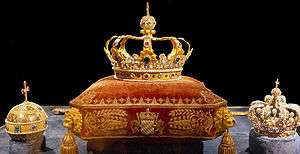Bavarian Crown Jewels
The Bavarian Crown Jewels are a set of crown jewels created for the Kingdom of Bavaria, which existed from 1806 to 1918. In 1806, as part of his wholescale re-ordering of the map of Europe, Emperor Napoléon I of the French upgraded the independent German duchy of Bavaria to full kingdom status. The former Duke of Bavaria, now King of Bavaria, Maximilian I, commemorated the fact by commissioning a set of crown jewels for use by Bavarian monarchs. However, there was no coronation ceremony, and the king never wore the crown in public. Rather, it was placed on a cushion when displayed on occasions such as the king's ascension or his funeral.[1]


Included in the regalia were:
- The Crown of Bavaria - the King's crown, which was set with rubies, diamonds, emeralds, sapphires and pearls;
- the Crown of the Queens of Bavaria, which was made for the then queen, Karoline of Baden, and which contains huge pearls and large diamonds;
- The 96 centimetre long State Sword;
- The Royal Orb - made of gold;
- The 89 centimetre long Royal Sceptre set with brilliants, emeralds and sapphires and the top is surmounted by a small round crown.
The Palatinate Pearl is also kept with the crown jewels, however it is not officially part of the collection. As a result of the First World War, the German monarchies were abolished in 1918 and since then, Bavaria has not had a monarch. The Bavarian Crown Jewels are currently on display in the Treasury of the Residenz palace in Munich.
References
- "Bavarian Palace Department | Munich Residenz | Treasury | Picture gallery". Residenz-muenchen.de. Retrieved 2008-10-12.